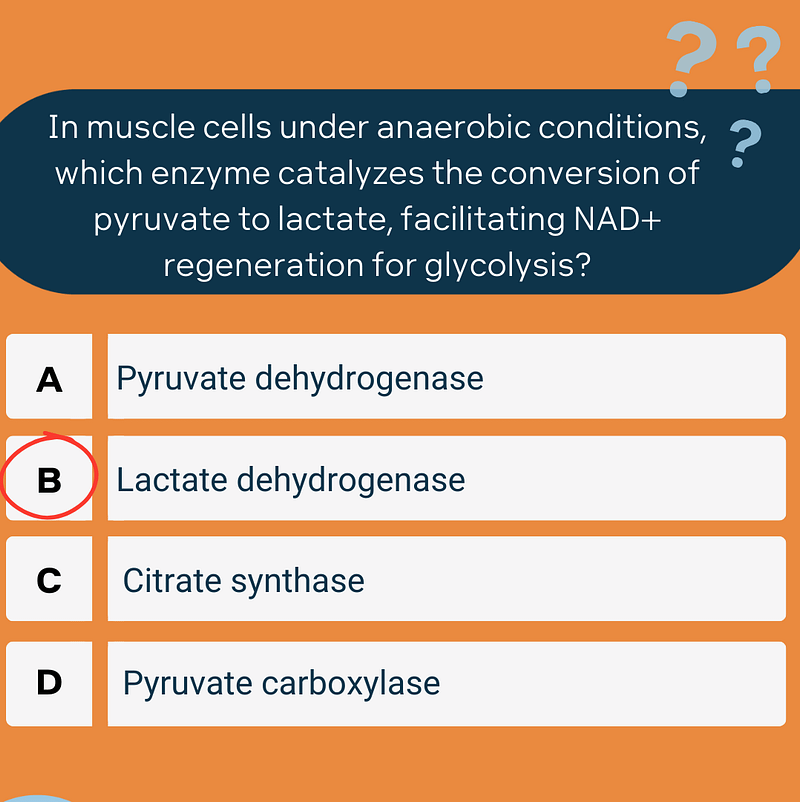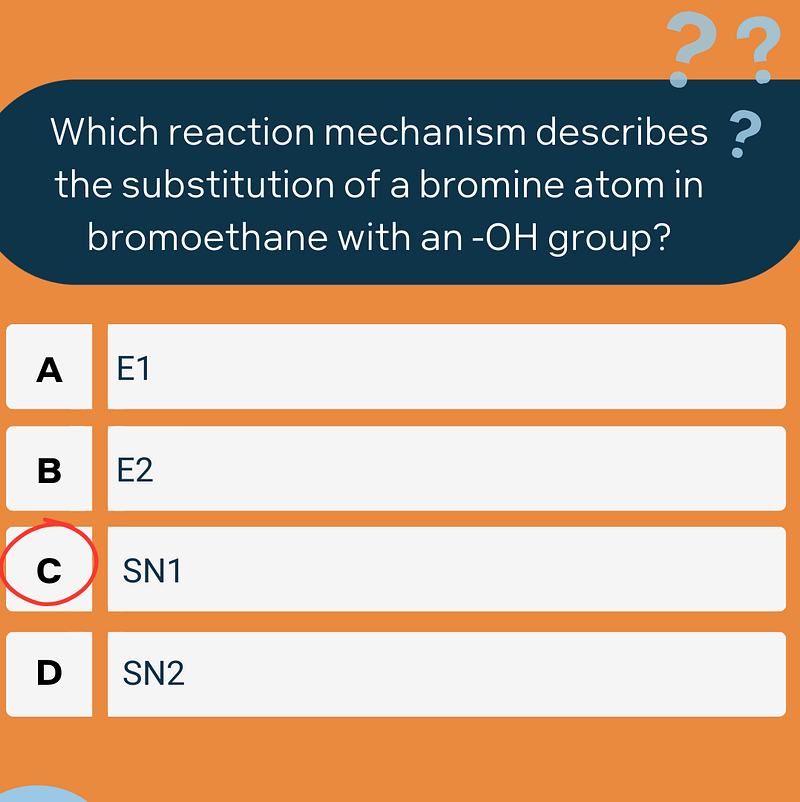MCAT Question of the Day
Check out our hand-picked question of the day!
Take a look at our expert video explanations or try a free sessions for individualized attention today!
This site is protected by reCAPTCHA and the Google Privacy Policy and Terms of Service apply.
Filter by category
9
- Biochemistry

Explanation
The correct answer is B, Lactate dehydrogenase. This question delves into specific enzyme activity under anaerobic conditions in muscle cells:
– Pyruvate dehydrogenase (A) is involved in the conversion of pyruvate to acetyl-CoA, a step that precedes the Citric Acid Cycle in aerobic conditions.
– Lactate dehydrogenase (B) is the enzyme that catalyzes the conversion of pyruvate, the end product of glycolysis, into lactate when oxygen is limited. This conversion is crucial for regenerating NAD+ from NADH, allowing glycolysis to continue producing ATP anaerobically.
– Citrate synthase (C) is an enzyme in the Citric Acid Cycle, not directly involved in the anaerobic pathway of muscle cells during intense exercise.
– Pyruvate carboxylase (D) is involved in gluconeogenesis, not in the anaerobic metabolism of muscle cells.
8
- Organic Chemisty

Explanation
The SN1 reaction mechanism involves a two-step process where the bromine atom first leaves, forming a carbocation, followed by the nucleophilic attack of the -OH group. This mechanism is typical for secondary and tertiary alkyl halides, like bromoethane.
7
- Physics

Explanation
The correct answer is B, 49 Joules. This question assesses understanding of energy conservation and kinematics, which are high-yield topics for the MCAT.
To solve this, we use the principle of conservation of mechanical energy. The mechanical energy (sum of potential and kinetic energy) of the ball is conserved during its fall, assuming no air resistance. The potential energy at the beginning (when the ball is held at 10 meters) is converted entirely into kinetic energy just before the ball hits the ground.
Potential energy (PE) at the beginning is given by PE=mgh*PE*=*mgh*, where m*m* is the mass, g*g* is the acceleration due to gravity (approximately 9.8 m/s29.8m/s2), and h*h* is the height.
Substituting the values, PE=0.5 kg×9.8 m/s2×10 m*PE*=0.5kg×9.8m/s2×10m, we can calculate the initial potential energy, which will equal the kinetic energy just before impact.
Let’s calculate it.
The calculation shows that the kinetic energy of the ball just before it hits the ground is 49 Joules. Therefore, the correct answer is B, 49 Joules. This question exemplifies the application of the conservation of energy principle, a fundamental concept in MCAT physics.
6
- Psychology & Sociology

Explanation
The correct answer is D, Pearson’s correlation coefficient. This question assesses understanding of statistical methods relevant to psychological and sociological research:
– Mean (A) and Median (B) are measures of central tendency that describe the central point of a data set but do not show relationships between variables.
– Standard deviation (C) measures the spread of data points in a dataset but does not indicate the relationship between different variables.
– Pearson’s correlation coefficient (D) is used to quantify the strength of the linear relationship between two variables. In this case, researchers need to understand the relationship between exercise frequency and mental health scores, making Pearson’s correlation coefficient the most appropriate statistical method
5
- Physics

Explanation
– A. Pressure is a scalar quantity, but its vector counterpart is not force. Force itself is a vector.
– B. Speed is a scalar quantity that measures how fast an object is moving, while Velocity is its vector counterpart, indicating both the speed and direction of the object’s motion.
– C. Work and Energy are both scalar quantities. Work is the process of energy transfer.
– D. Power is a scalar quantity measuring the rate of work done or energy conversion, whereas Torque is a vector quantity representing the rotational force.
4
- General Chemistry

Explanation
The correct answer is B, H2CO3/HCO3^-. This question assesses understanding of renal physiology and its role in acid-base balance:
– HCl/NaCl (A) is not a buffer system.
– H2CO3/HCO3^- (B) is the carbonic acid-bicarbonate buffer system, crucial in blood pH regulation. The kidneys regulate this system by reabsorbing bicarbonate and secreting hydrogen ions.
– CaCO3/Ca(HCO3)2 (C) is not a primary buffer system in human blood.
– HPO4^2-/H2PO4^- (D) is the phosphate buffer system, but it’s less significant in the context of renal regulation compared to the bicarbonate system.